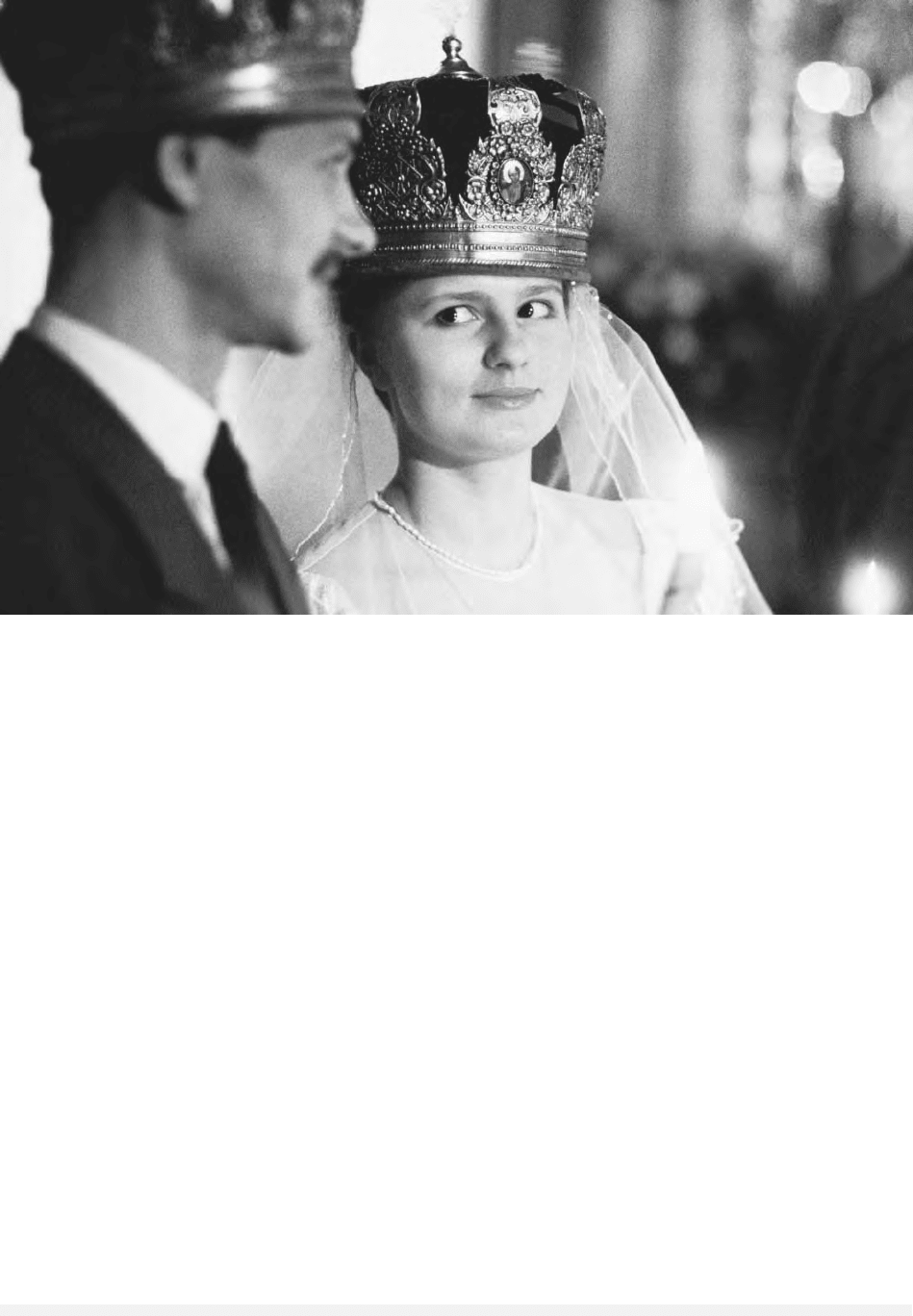Encyclopedia of Russian History
Подождите немного. Документ загружается.


begun. Moreover, she was determined to repair the
economic–financial ravages of the war that had just
ended. It was one thing to declare a new policy,
however, and something else to institute it. In
preparing the two manifestoes of 1762–1763 the
Senate discovered many partial precedents and sev-
eral concrete impediments to welcoming masses of
immigrants. More than six months elapsed be-
tween the issuance of the two manifestoes, during
which time governments were consulted and insti-
tutions formulated to care for the anticipated new-
comers. It was decided that the manifesto should
list the specific lands available for settlement and
not exclude any groups. Drawing on foreign prece-
dent and the suggestion of Senator Peter Panin, the
manifesto of 1763 established a special government
office with jurisdiction over new settlers, the
Chancery of Guardianship of Foreigners. The first
head, Count Grigory Orlov, Catherine’s common–
law husband and leader of her seizure of the throne,
personified the office’s high status. The new Russ-
ian immigration policy offered generous material
incentives, promised freedom of religion and ex-
emption from military recruitment, and guaran-
teed exemption from enserfment and freedom to
leave. These provisions governed immigration pol-
icy until at least 1804 and for many decades there-
after. The manifesto of 1763 did not specifically
exclude Jews, although Elizabeth’s regime banned
them as “Killers of Christ,” for Catherine highly re-
garded their entrepreneurship and unofficially en-
couraged their entry into New Russia (Ukraine) in
1764.
European immigrants responded eagerly to the
manifesto, some twenty thousand arriving during
Catherine’s reign. Germans settling along the Volga
were the largest group, especially the Herrnhut
(Moravian Brethren) settlement at Sarepta near
Saratov and Mennonite settlements in southern
Ukraine. Because of the empire’s largely agrarian
economy, most settlers were farmers. The expense
of the program was large, however, so its cost–
effectiveness is debatable. A century later many
Volga Germans resettled in the United States, some
still decrying Catherine’s allegedly broken promises.
See also: CATHERINE II; JEWS; ORLOV, GRIGORY GRIG-
ORIEVICH; PALE OF SETTLEMENT
BIBLIOGRAPHY
Bartlett, Roger P. (1979). Human Capital: The Settlement
of Foreigners in Russia 1762-1804. Cambridge, UK:
Cambridge University Press.
Khodarkovsky, Michael. (2002). Russia’s Steppe Frontier:
The Making of a Colonial Empire, 1500-1800. Bloom-
ington: Indiana University Press.
J
OHN
T. A
LEXANDER
MANSI
The 8,500 Mansi (1989 census), formerly called
Voguls, live predominantly in the Hanti-Mansi Au-
tonomous Region (Okrug), in the swampy basin of
the Ob river. Their language belongs to the Ugric
branch of the Finno-Ugric family. It has little mu-
tual intelligibility with the related Hanti language,
farther northeast, and essentially none with Mag-
yar (Hungarian). Most Mansi have Asian features.
One of the most distinctive features of Mansi (and
Hanti) culture is an elaborate bear funeral cere-
mony, honoring the slain beast.
The Mansi historical homeland straddled the
middle Urals, southwest of their present location
on the Konda River. They offered spirited resistance
to Russian encroachment during the 1400s, high-
lighted by prince Asyka’s counterattack in 1455.
The Russians destroyed the last major Mansi prin-
cipality, Konda, in 1591. Within one generation,
Moscow ignored whatever capitulation treaties had
been signed. As settlers poured into the best Mansi
agricultural lands, the Mansi were soon reduced to
a small hunting and fishing population. By 1750
most were forced to accept the outer trappings of
Greek Orthodoxy, while practicing animism in se-
cret. Russian traders reduced people unfamiliar
with the notion of money and prices to loan slav-
ery that lasted for generations.
When the Ostiako-Vogul National Okrug Dis-
trict—the present Hanti-Mansi Autonomous
Oblast—was created in 1930, the indigenous pop-
ulation was already down to 19 percent of the to-
tal population. By 1989, the population had
dropped to 1.4 percent, due first to a massive in-
flux of deportees and then to free labor, after dis-
covery of oil during the 1950s. The curse of Arctic
oil impacted the natives, who were crudely dispos-
sessed, as well as the fragile ecosystem. Gas torch-
ing and oil spills became routine.
Post-Soviet liberalization enabled the Hanti and
Mansi to organize Spasenie Ugry (Salvation of Yu-
gria, the land of Ugrians) that gave voice to in-
digenous and ecological concerns. Thirty-seven
percent of the Mansi population (and few young
MANSI
893
ENCYCLOPEDIA OF RUSSIAN HISTORY

people) spoke Mansi in the early 1990s. A weekly
newspaper, Luima Serikos, had a circulation of 240
in 1995. Novels on Mansi topics by Yuvan Sestalov
(b. 1937) have many readers in Russia.
See also: FINNS AND KARELIANS; NATIONALITIES POLICIES,
SOVIET; NATIONALITIES POLICIES, TSARIST; NORTHERN
PEOPLES
BIBLIOGRAPHY
Forsyth, James. (1992). A History of the Peoples of Siberia:
Russia’s North Asian Colony, 1581–1990. Cambridge,
UK: Cambridge University Press.
Taagepera, Rein. (1999). The Finno-Ugric Republics and the
Russian State. London: Hurst.
R
EIN
T
AAGEPERA
MARI EL AND THE MARI
The Mari, or Cheremis, are an indigenous people of
the European Russian interior; their language and
that of the Mordvins compose the Volgaic branch
of the Finno-Ugric language family.
As subjects of the Volga Bolgars and Kazan
Tatars, medieval Mari tribes experienced cultural
and linguistic influences mainly from their Turkic
neighbors. Later on, Slavic contacts became promi-
nent, and the Russian language became the princi-
pal source of lexical and syntactic borrowing. The
early twentieth-century initiatives to create a sin-
gle literary language did not come to fruition. Con-
sequently, there are two written standards of Mari:
Hill and Meadow. The speakers of various western,
or Hill Mari, dialects constitute hardly more than
10 percent of the Mari as a whole.
In the basin of the Middle Volga, the medieval
Mari distribution area stretched from the Volga-
Oka confluence to the mouth of the Kazanka River.
Under Tatar rule, the Mari were active participants
in Kazan’s war efforts. Apparently due to their loy-
alty and peripheral location, Mari tribal communi-
ties were granted home rule. However, the final
struggle between the Kazan Khanate and Moscow
brought an intraethnic cleavage: the Hill Mari sided
with the Russians, whereas the Meadow Mari re-
mained with the Tatars until the fall of Kazan in
1552.
The submission to Moscow was painful: The
second half of the sixteenth century saw a series of
uprisings, known as the Cheremis Wars, which
decimated the Meadow Mari in particular. The
Russian invasions triggered population movements
that also reshaped the Mari settlement area: a part
of the Meadow Mari migrated to the Bashkir lands
and towards the Urals. For about two hundred
years, the resettlement was sustained by land
seizures, fugitive peasant migrations, and Chris-
tianization policies. The outcome of all this was the
formation of the Eastern Mari. In terms of religion,
these Mari have largely kept their traditional “pa-
ganism,” whereas their Middle Volga coethnics are
mostly Orthodox, or in a synchretic way combine
animism with Christianity.
The Mari ethnic awakening took its first steps
with the 1905 and 1917 Revolutions. In 1920 the
Bolsheviks established the Mari autonomous
province. It was elevated to the status of an au-
tonomous republic in 1936—the year of the Stal-
inist purges of the entire ethnic intelligentsia. Since
1992, the republic has been known as the Repub-
lic of Mari El.
At the time of the 1989 census, 324,000 Mari
out of a total of 671,000 were residents of their
titular republic. There the Mari constituted 43.2
percent of the inhabitants, whereas Russians made
up 47.5 percent. Outside Mari El, the largest Mari
populations were found in Bashkortostan (106,000)
as well as in Kirov and Sverdlovsk provinces
(44,000 and 31,000 respectively). Indicative of lin-
guistic assimilation, 17 percent of the Mari con-
sidered Russian their native language during the
1994 microcensus.
In 2000 Mari El was a home for 759,000 peo-
ple. Within Russia, it is an agricultural region, poor
in natural resources and heavily dependent on fed-
eral subsides. Within the republic’s political elite,
the Mari have mainly performed secondary roles,
and this situation has deteriorated further since the
mid-1990s. Because Russians outnumber the Mari,
and because the Mari still lag behind in terms of
urbanity, education, and ethnic consciousness,
Russians dominate the republic’s political life.
See also: FINNS AND KARELIANS; NATIONALITIES POLICIES,
SOVIET; NATIONALITIES POLICIES, TSARIST.
BIBLIOGRAPHY
Fryer, Paul, and Lallukka, Seppo. (2002). “The Eastern
Mari.” <http://www.rusin.fi/eastmari/home.htm>.
Lallukka, Seppo. (1990). The East Finnic Minorities in the
Soviet Union: An Appraisal of the Erosive Trends. (An-
MARI EL AND THE MARI
894
ENCYCLOPEDIA OF RUSSIAN HISTORY

nales Academiae Scientiarum Fennicae, Ser. B, vol.
252). Helsinki: Suomalainen Tiedeakatemia.
Taagepera, Rein. (1999). The Finno-Ugric Republics and the
Russian State. London: Hurst.
S
EPPO
L
ALLUKKA
MARKET SOCIALISM
The economic doctrine of market socialism holds
that central planners can make active and efficient
use of “the market” as a mechanism for imple-
menting socially desired goals, which are developed
and elaborated through central planning of eco-
nomic activity. Focusing on the elimination of pri-
vate property and wealth, and on the central
determination and control of all investment and de-
velopment decisions, it posits that the planned de-
termination and adjustment of producers’ and asset
prices could allow markets to implement the de-
sired allocations in a decentralized manner without
sacrificing central or social control over outcomes
or incomes. Thus egalitarian social outcomes and
dynamic economic growth can be achieved simul-
taneously, without the disruptions and suffering
imposed by poorly coordinated private investment
decisions resulting in a wasteful business cycle.
The idea of market socialism arose from the re-
alization that classical socialism, involving the col-
lective provision and distribution of goods and
services in natural form, without the social con-
trivances of property, markets, and prices, was not
feasible, since rational collective control of eco-
nomic activity requires calculations that cannot
rely consistently on “natural unit” variables such
as energy or labor amounts. It also became clear
that the existing computing capabilities were inad-
equate for deriving a consistent economic plan from
a general equilibrium problem. This led, in the So-
cialist Calculation Debate of the 1930s, to the sug-
gestion (most notably by Oskar Lange) that a
Socialist regime, assuming ownership of all means
of production, could use markets to find relevant
consumers’ prices and valuations while maintain-
ing social and state control over production, income
determination, investment, and economic develop-
ment. Managers would be instructed to minimize
costs, while the planning board would adjust pro-
ducers’ prices to eliminate disequilibria in the mar-
kets for final goods. Thus, at a socialist market
equilibrium, the classical marginal conditions of
static efficiency would be maintained, while the
State would ensure equitable distribution of in-
comes through its allocation of the surplus (profit)
from efficient production and investment in so-
cially desirable planned development.
Another version of market socialism arose as a
result of the reform experiences in east-central Eu-
rope, particularly the labor-managed economic
system of Yugoslavia that developed following
Marshal Tito’s break with Josef Stalin in 1950.
This gave rise to a large body of literature on
the “Illyrian Firm” with decentralized, democratic
control of production by workers’ collectives in a
market economy subject to substantial macroeco-
nomic planning and income redistribution through
taxation and subsidies. The economic reforms in
Hungary (1968), Poland (1981), China after 1978,
and Gorbachev’s Russia (1987–1991) involved
varying degrees of decentralization of State Social-
ism and its administrative command economy,
providing partial approximations to the classical
market socialist model of Oskar Lange. This expe-
rience highlighted the difficulties of planning for
and controlling decentralized markets, and revealed
the failure of market socialism to provide incen-
tives for managers to follow the rules necessary for
economic efficiency. Faced with these circum-
stances, proponents of market socialism moved be-
yond state ownership and control of property to
various forms of economic democracy and collec-
tive property, accepting the necessity of real mar-
kets and market prices but maintaining the classical
socialist rejection of fully private productive prop-
erty. The early debates on market socialism are best
seen in Friedrich A. von Hayek (1935), while the
current state of the debate is presented in Pranab
Bardhan and John E. Roemer (1993).
See also: PERESTROIKA; PLANNERS’ PREFERENCE; SOCIAL-
ISM; STATE ORDERS
BIBLIOGRAPHY
Bardhan, Pranab, and Roemer, John E., eds. (1993). Mar-
ket Socialism: The Current Debate. Oxford: Oxford
University Press.
Granick, David. (1975). Enterprise Guidance in Eastern Eu-
rope: A Comparison of Four Socialist Economies. Prince-
ton, NJ: Princeton University Press.
Hayek, Friedrich A. von, ed. (1935). Collectivist Economic
Planning: Critical Studies on the Possibilities of Social-
ism. London: Routledge.
Kornai, János. (1992). The Socialist System: The Political
Economy of Communism. Princeton, NJ: Princeton
University Press.
MARKET SOCIALISM
895
ENCYCLOPEDIA OF RUSSIAN HISTORY

Lange, Oskar, and Taylor, Fred M. (1948). On the Eco-
nomic Theory of Socialism. Minneapolis: University of
Minnesota Press.
R
ICHARD
E
RICSON
MARRIAGE AND FAMILY LIFE
As elsewhere in Europe, marriage and family life in
Russia have varied across time and by social group,
reflecting the complex interplay of competing
ideals, changing patterns of social and economic or-
ganization, differing forms of political organization
and levels of state intrusiveness, and the effects of
cataclysmic events. If in the long run the outcome
of this interplay of forces has been a family struc-
ture and dynamic that conform essentially with
those found in modern European societies, the de-
velopment of marriage and the family in Russia
nevertheless has followed a distinctive path. This
development can be divided into three broad peri-
ods: the centuries preceding the formation of the
Russian Empire during the early eighteenth cen-
tury, the imperial period (1698–1917), and the pe-
riod following the Bolshevik Revolution and
establishment of the Soviet state in October 1917.
While the pace of development and change varied
significantly between different social groups dur-
ing each of these periods, each period nonetheless
was characterized by a distinctive combination
of forces that shaped marital and family life and
family structures. In Russia’s successive empires,
moreover, important differences also often existed
between the many ethno-cultural and religious
groups included in these empires. The discussion
that follows therefore concerns principally the
Slavic Christian population.
PRE-IMPERIAL RUSSIA
Although only limited sources are available for the
reconstruction of marital and family life in me-
dieval Russia, especially for nonelite social groups,
there appears to have been broad continuity in the
structure and functioning of the family through-
out the medieval and early modern periods. Fam-
ily structures and interpersonal relations within
marriage and the family were strongly shaped by
the forms of social organization and patterns of
economic activity evolved to secure survival in a
harsh natural as well as political environment.
Hence, constituting the primary unit of production
and reproduction, and providing the main source
of welfare, personal status, and identity, families
in most instances were multigenerational and
structured hierarchically, with authority and eco-
nomic and familial roles distributed within the
family on the basis of gender and seniority. While
scholars disagree over whether already by 1600 the
nuclear family had begun to displace the multi-
generational family among the urban population,
this development did not affect the patriarchal
character or the social and economic functions of
either marriage or the family. Reflecting and rein-
forcing these structures and functions, the mar-
riage of children was arranged by senior family
members, with the economic, social, and political
interests of the family taking precedence over indi-
vidual preference. Land and other significant assets,
too, generally were considered to belong to the fam-
ily as a whole, with males enjoying preferential
treatment in inheritance. Marriage appears to have
been universal among all social groups, with chil-
dren marrying at a young age, and for married
women, childbirth was frequent.
After the conversion of Grand Prince Vladimir
of Kievan Rus to Christianity in 988, normative
rules governing marriage and the family also were
shaped and enforced by the Orthodox Church, al-
though the effective influence of the Church spread
slowly from urban to rural areas. Granted exten-
sive jurisdiction over marital and family matters
first by Kievan and then by Muscovite grand
princes, the Church used its authority to establish
marriage as a religious institution and to attempt
to bring marital and family life into conformity
with its doctrines and canons. For example, the
Church sought—with varying degrees of success—
to limit the formation of marriages through re-
strictions based on consanguinity and age, to
restrict marital dissolution to the instances defined
by canon law, to limit the possibility of remarriage,
and to confine sexual activity to relations between
spouses within marriage for the purpose of pro-
creation. At the same time, through its teachings,
canonical rules, and ecclesiastical activities, the
Church reinforced the patriarchal order within
marriage and the family, thereby providing a reli-
gious sanction for established social structures and
practices. Hence the extent to which the Church
transformed or merely reinforced existing ideals of
and relationships within marriage and the family
remains disputed.
Although patriarchal attitudes and structures
and a gendered division of labor also prevailed
within elite households, the role of family and lin-
MARRIAGE AND FAMILY LIFE
896
ENCYCLOPEDIA OF RUSSIAN HISTORY

eage in determining relative status within and
between elite groups, access to beneficial appoint-
ments and the material rewards that followed from
them, and the prospects for forming advantageous
marriage alliances between families imparted dis-
tinctive characteristics to elite family life, especially
after the late fifteenth century. The practice among
the Muscovite elite of secluding women in separate
quarters (the terem), for example, which reached its
greatest intensity during the seventeenth century,
appears to have been due largely to the desire to
protect family honor and ensure the marriage util-
ity of daughters in a context in which the elite was
growing in size and complexity. Seclusion itself,
however, considerably increased the politically im-
portant role of married women in arranging and
maintaining family alliances. Similarly, the devel-
opment of a system of service tenements in land to
support the expansion especially of military servi-
tors after the late fifteenth century led initially to
a deterioration in the property and inheritance
rights of elite women. Yet such women also often
had principal responsibility for managing the es-
tates and other affairs of husbands who frequently
were away on military campaigns or carrying out
other service assignments. Hence within the Mus-
covite elite, and quite likely among other social
groups in pre-Petrine Russia as well, the normative
ideal and legal rules supporting the patriarchal
family often concealed a more complex reality. This
ideal nonetheless provided a powerful metaphor
that helped to legitimize and integrate the familial,
social, and political orders.
IMPERIAL RUSSIA
The history of marriage and the family during the
imperial period was marked both by a complex pat-
tern of continuity and change and by sharp diver-
sity between social groups, as the exposure of
different groups to the forces of change varied sig-
nificantly. Nonetheless, by the early twentieth cen-
tury the long-term trend across the social spectrum
was toward smaller families, the displacement of
the multigenerational family by the nuclear fam-
ily, a higher age at the time of first marriage for
both men and women, declining birth rates, an in-
creased incidence of marital dissolution, and, in ur-
ban areas, a decline in the frequency of marriage.
Within the family, the structure of patriarchal au-
thority was eroding and the ideal itself was under
attack.
The groups that were exposed earliest and most
intensively to the combination of forces lying
behind these trends were the nobility, state offi-
cialdom, the clergy, and a newly emergent intelli-
gentsia and largely urban bourgeoisie. During the
eighteenth century, for example, the nobility rep-
resented the main target and then chief ally of the
state in its efforts to inculcate European cultural
forms and modes of behavior and to promote for-
mal education and literacy. Among the effects of
such efforts was a new public role for women and
the dissemination of ideals of marriage, family, and
the self that eventually came to challenge the pa-
triarchal ideal. By helping to produce by the first
half of the nineteenth century a more profession-
alized, predominantly landless, and largely urban
civil officialdom, as well as a chiefly urban cultural
intelligentsia and professional bourgeoisie, changes
in the terms of state service and the expansion of
secondary and higher education both provided a re-
ceptive audience for new ideals of marriage and the
family and eroded dependency on the extended
family. By expanding the occupational opportuni-
ties not only for men but also for women outside
the home, the development of trade, industry, pub-
lishing, and the professions had similar effects.
Most of these new employment opportunities were
concentrated in Russia’s rapidly growing cities,
where material and physical as well as cultural con-
ditions worked to alter the family’s role, structures,
and demographic characteristics. For this reason,
the marital and demographic behavior and family
structures of urban workers also exhibited early
change.
At least until after the late 1850s, by contrast,
marriage and family life among the peasantry,
poorer urban groups, and the merchantry dis-
played greater continuity with the past. This con-
tinuity resulted in large part from the strength of
custom and the continued economic, social, and
welfare roles of the multigenerational, patriarchal
family among these social groups and, at least
among the peasantry, from the operation of com-
munal institutions and the coincident interests of
family patriarchs (who dominated village assem-
blies), noble landowners, and the state in preserv-
ing existing family structures. Facilitated by the
abolition of serfdom in 1861, however, family
structures and demographic behavior even among
the peasantry began slowly to change, especially
outside of the more heavily agricultural central
black earth region. In particular, the increased fre-
quency of household division occurring after the
emancipation contributed to a noticeable reduction
in family size and a decline in the incidence of the
multigenerational family by the last third of the
MARRIAGE AND FAMILY LIFE
897
ENCYCLOPEDIA OF RUSSIAN HISTORY

century, although most families still passed
through a cycle of growth and division that in-
cluded a multigenerational stage. While marriage
remained nearly universal, the age at first marriage
also rose for both men and women, with the re-
sult that birth rates declined somewhat. The
growth of income from local and regional wage la-
bor, trade, and craft production and the rapid ex-
pansion of migratory labor contributed to all these
trends, while also helping to weaken patriarchal
structures of authority within the family, a process
given further impetus by the exposure of peasants
to urban culture through migratory labor, mili-
tary service, and rising literacy. Although most
peasant migrants to cities, especially males, re-
tained ties with their native village and household,
and consequently continued to be influenced by
peasant culture, a significant number became per-
manent urban residents, adopting different family
forms and cultural attitudes as a result. With the
rapid growth of Russian cities and the transfor-
mation of the urban environment that took place
after the late 1850s, family forms and demographic
behavior among the poorer urban social groups and
the merchantry also began to change in ways sim-
ilar to other urban groups.
Normative ideals of marriage and the family
likewise exhibited significant diversification and
change during the imperial period, a process that
accelerated after the late 1850s. If closer integra-
tion into European culture exposed Russians to a
wider and shifting variety of ideals of marriage, the
family, and sexual behavior, the development of a
culture of literacy, journalism and a publishing in-
dustry, and an ethos of civic activism and profes-
sionalism based on faith in the rational use of
specialized expertise broadened claims to the au-
thority to define such ideals. These developments
culminated in an intense public debate over reform
of family law—and of the family and society
through law—after the late 1850s. Very broadly,
emphasizing a companionate ideal of marriage, the
need to balance individual rights with collective re-
sponsibilities and limited authority within mar-
riage and the family, and the necessity of adapting
state law and religious doctrines to changing social
MARRIAGE AND FAMILY LIFE
898
ENCYCLOPEDIA OF RUSSIAN HISTORY
A young couple exchanges their marriage vows during an Orthodox ceremony in Chelyabinsk. © P
ETER
T
URNLEY
/CORBIS

and historical conditions, advocates of reform fa-
vored the facilitation of marital dissolution, equal-
ity between spouses in marriage, greater rights for
children born out of wedlock, the recasting of in-
heritance rights based on sexual equality and the
nuclear family, and the decriminalization of vari-
ous sexual practices as well as of abortion. Many
of these principles in fact were embodied in draft
civil and criminal codes prepared by government
reform commissions between 1883 and 1906, nei-
ther of which was adopted, and proposals to ex-
pand the grounds for divorce made by a series of
committees formed within the Orthodox Church
between 1906 and 1916 proved similarly unsuc-
cessful. Socialist activists adopted an even more
radical position on the reconstitution of marriage
and the family, in some cases advocating the so-
cialization of the latter. Opponents of reform, by
contrast, stressed the social utility, naturalness, and
divine basis of strong patriarchal authority within
marriage and the family, the congruence of this
family structure with Russian cultural traditions,
and the role of the family in upholding the auto-
cratic social and political orders. Although signifi-
cant reforms affecting illegitimate children,
inheritance rights, and marital separation were en-
acted in 1902, 1912, and 1914, respectively, deep
divisions within and between the state, the Ortho-
dox Church, and society ensured that reform of
marriage and the family remained a contentious is-
sue until the very end of the autocracy, and be-
yond.
SOVIET RUSSIA
With respect to marriage and the family, the long-
term effect of the Soviet attempt to create a mod-
ern socialist society was to accelerate trends already
present in the early twentieth century. Hence, by
the end of the Soviet period, among all social groups
family size had declined sharply and the nuclear
family had become nearly universal, the birth rate
had dropped significantly, marriage no longer was
universal, and the incidence of marital dissolution
had risen substantially. But if by the 1980s the
structure and demographic characteristics of the
Russian family had come essentially to resemble
those found in contemporary European societies,
the process of development was shaped by the dis-
tinctive political and economic structures and poli-
cies of Soviet-style socialism.
Soviet policies with respect to marriage and the
family were shaped initially by a combination of
radical ideological beliefs and political considera-
tions. Hence, in a series of decrees and other en-
actments promulgated between October 1917 and
1920, the new Soviet government introduced for-
mal sexual equality in marriage, established divorce
on demand, secularized marriage, drastically cur-
tailed inheritance and recast inheritance rights on
the basis of sexual equality and the nuclear fam-
ily, and legalized abortion. The party-state leader-
ship also proclaimed the long-term goal of the
socialization of the family through the develop-
ment of an extensive network of social services and
communal dining. These measures in part reflected
an ideological commitment to both the liberation
of women and the creation of a socialist society.
But they also were motivated by the political goals
of attracting the support of women for the new
regime and of undermining the sources of opposi-
tion to it believed to lie in patriarchal family struc-
tures and attitudes and in marriage as a religious
institution. In practice, however, the policies added
to the problems of family instability, homelessness,
and child abandonment caused mainly by the harsh
and disruptive effects of several years of war, rev-
olution, civil war, and famine. For this reason,
while welcomed by radical activists and some parts
of the population, Soviet policies with respect to
marriage and the family also provoked consider-
able opposition, especially among women and the
peasantry, who for overlapping but also somewhat
different reasons saw in these policies a threat to
their security and self-identity during a period of
severe dislocation. In important respects, Soviet
propaganda and policies in fact reinforced the self-
image that partly underlay the opposition of
women to its policies by stressing the ideal and du-
ties of motherhood. Yet the direction of Soviet poli-
cies remained consistent through the 1920s, albeit
not without controversy and dissent even within
the party, with these policies being embodied in the
family codes of 1922 and 1926.
The severe social disruptions, strain on re-
sources, and deterioration of already limited social
services caused by the collectivization of agricul-
ture, the rapid development of industry, the aboli-
tion of private trade, and the reconstruction of the
economy between the late 1920s and the outbreak
of war in 1941, however, led to a fundamental shift
in Soviet policies with respect to marriage and the
family. With its priorities now being economic
growth and social stabilization, the Soviet state ide-
alized the socialist family (which in essence closely
resembled the family ideal of prerevolutionary lib-
eral and feminist reformers), which was proclaimed
to be part of the essential foundation of a socialist
MARRIAGE AND FAMILY LIFE
899
ENCYCLOPEDIA OF RUSSIAN HISTORY

society. A series of laws and new codes enacted be-
tween 1936 and 1944 therefore attempted both to
strengthen marriage and the family and to en-
courage women to give birth more frequently: Di-
vorce was severely restricted, children born out of
wedlock were deprived of any rights with respect
to their father, thus reestablishing illegitimacy of
birth, abortion was outlawed, and a schedule of re-
wards for mothers who bore additional children
was established. Although the goals of women’s
liberation and sexual equality remained official pol-
icy, they were redefined to accommodate a married
woman’s dual burden of employment outside the
home and primary responsibility for domestic
work. Economic necessity in fact compelled most
women to enter the workforce, regardless of their
marital status, with only the wives of the party-
state elite being able to choose not to do so. Despite
the changes in normative ideals and the law, how-
ever, the effects of Soviet social and economic poli-
cies in general and of the difficult material
conditions resulting from them were a further re-
duction in average family size and decline in the
birth rate and the disruption especially of peasant
households, as family members were arrested, mi-
grated to cities in massive numbers, or died as a
result of persecution or famine. The huge losses
sustained by the Soviet population during World
War II gave further impetus to these trends and,
by creating a significant imbalance between men
and women in the marriage-age population, con-
siderably reduced the rate of marriage and compli-
cated the formation of families for several decades
after the war.
The relaxation of political controls on the dis-
cussion of public policy by relevant specialists af-
ter the death of Josef Stalin in 1953 contributed to
another shift in Soviet policies toward marriage and
the family during the mid-1960s. Divorce again be-
came more accessible, fathers could be required to
provide financial support for their children born
out of wedlock, and abortion was re-legalized and,
given the scarcity of reliable alternatives, quickly
became the most common form of birth control
practiced by Russian women. Partly as a result of
these measures, the divorce rate within the Rus-
MARRIAGE AND FAMILY LIFE
900
ENCYCLOPEDIA OF RUSSIAN HISTORY
Following Soviet tradition, a wedding party walks to Red Square to have pictures taken. © P
ETER
T
URNLEY
/CORBIS

sian population rose steadily after the mid-1960s,
with more than 40 percent of all marriages ending
in divorce by the 1980s, and the birth rate contin-
ued to decline. But these trends also gained impe-
tus from the growth of the percentage of the
Russian population, women as well as men, re-
ceiving secondary and tertiary education, from the
nearly universal participation of women in the
workforce, from the continued shift of the popu-
lation from the countryside to cities (the Russian
population became predominantly urban only af-
ter the late 1950s), and from the limited availabil-
ity of adequate housing and social services in a
context in which women continued to bear the chief
responsibilities for child-rearing and domestic
work. These latter problems contributed to the
reemergence in the urban population of a modified
form of the multigenerational family, as the prac-
tices of a young couple living with the parents of
one partner while waiting for their own apartment
and of a single parent living especially with his or
usually her mother appear to have increased. In the
countryside, the improvement in the living condi-
tions of the rural population following Stalin’s
death, their inclusion in the social welfare system,
yet the continued out-migration especially of
young males seeking a better life in the city also
led to a decline in family size, as well as to a dis-
proportionately female and aging population,
which affected both the structure of rural families
and the rate of their formation. Nonetheless, the
ideals of the nuclear family, marriage, and natural
motherhood remained firmly in place, both in of-
ficial policy and among the population.
See also: ABORTION POLICY; FAMILY CODE OF 1926; FAM-
ILY CODE ON MARRIAGE, THE FAMILY, AND
GUARDIANSHIP; FAMILY EDICT OF 1944; FAMILY LAWS
OF 1936; FEMINISM
BIBLIOGRAPHY
Clements, Barbara Evans; Engel, Barbara Alpern; and
Worobec, Christine D., eds. (1991). Russia’s Women:
Accommodation, Resistance, Transformation. Berkeley:
University of California Press.
Engel, Barbara Alpern. (1994). Between the Fields and the
City: Women, Work, and Family in Russia, 1861–1914.
New York: Cambridge University Press.
Freeze, ChaeRan Y. (2002). Jewish Marriage and Divorce
in Imperial Russia. Hanover, NH: Brandeis Univer-
sity Press.
Goldman, Wendy Z. (1993). Women, the State, and Rev-
olution: Soviet Family Policy and Social Life,
1917–1936. New York: Cambridge University Press.
Hubbs, Joanna. (1988). Mother Russia: The Feminine Myth
in Russian Culture. Bloomington: Indiana University
Press.
Lapidus, Gail Warshofsky. (1978). Women in Soviet Soci-
ety: Equality, Development, and Social Change. Berke-
ley: University of California Press.
Levin, Eve. (1989). Sex and Society in the World of the Or-
thodox Slavs, 900–1700. Ithaca, NY: Cornell Univer-
sity Press.
Marrese, Michelle Lamarche. (2002). A Woman’s King-
dom. Noblewomen and the Control of Property in Rus-
sia, 1700–1861. Ithaca, NY: Cornell University Press.
Mironov, Boris N., with Eklof, Ben. (2000). The Social
History of Imperial Russia, 1700-1917. 2 vols. Boul-
der, CO: Westview Press.
Pouncy, Carolyn J., ed. and tr. (1994). The “Domostroi”:
Rules for Russian Households in the Time of Ivan the
Terrible. Ithaca, NY: Cornell University Press.
Ransel, David L., ed. (1978). The Family in Imperial Rus-
sia: New Lines of Historical Research. Urbana: Uni-
versity of Illinois Press.
Ransel, David L. (2000). Village Mothers: Three Generations
of Change in Russia and Tataria. Bloomington: Indi-
ana University Press.
Schlesinger, Rudolf, comp. (1949). Changing Attitudes in
Soviet Russia: The Family in the USSR. London: Rout-
ledge and Paul.
Wagner, William G. (1994). Marriage, Property, and Law
in Late Imperial Russia. Oxford: Clarendon Press.
Worobec, Christine D. (1991). Peasant Russia: Family and
Community in the Post-Emancipation Period. Prince-
ton, NJ: Princeton University Press.
W
ILLIAM
G. W
AGNER
MARTOV, YULI OSIPOVICH
(1873–1923), founder of Russian social democracy,
later leader of the Menshevik party.
Born Yuli Osipovich Tsederbaum to a middle–
class Jewish family in Constantinople, Yuli Martov
established the St. Petersburg Union of Struggle for
the Liberation of the Working Class with Lenin in
1895. The following year, Martov was sentenced to
three years’ exile in Siberia. After serving his term,
he joined Lenin in Switzerland where they launched
the revolutionary Marxist newspaper Iskra. Martov
broke with Lenin at the Russian Social Democratic
Party’s Second Congress in Brussels in 1903, when
he opposed his erstwhile comrade’s bid for leader-
ship of the party and his demand for a narrow,
MARTOV, YULI OSIPOVICH
901
ENCYCLOPEDIA OF RUSSIAN HISTORY

highly centralized party of professional revolution-
aries, instead calling for a broad-based party with
mass membership. Lenin labelled Martov’s sup-
porters the Menshevik (minority) faction; his own
followers constituted the Bolsheviks (majority).
While Lenin proclaimed that socialists should re-
spond to a successful bourgeois revolution by tak-
ing immediate steps to prepare for their own
takeover of government, Martov advocated absten-
tion from power and a strategy of militant oppo-
sition rooted in democratic institutions such as
workers’ soviets, trades unions, cooperatives, or
town and village councils. These “organs of revo-
lutionary self-government” would impel the bour-
geois government to implement political and
economic reform, which would, in time, bring
about conditions favorable to a successful, peaceful,
proletarian revolution. After the outbreak of war,
Martov was a founder of the Zimmerwald move-
ment, which stood for internationalism and “peace
without victory” against both the “defensism” of
some socialist leaders and Lenin’s ambition to trans-
form the imperialist war into a revolutionary civil
war. Martov returned to Russia in mid-May 1917.
His internationalist position and advocacy of mili-
tant opposition to bourgeois government brought
him into open conflict with Menshevik leaders such
as Irakly Tsereteli, who proclaimed “revolutionary
defensism” and had days earlier entered a coalition
with the Provisional Government’s liberal ministers.
The collapse of the first coalition ministry in early
July prompted Martov to declare that the time was
now ripe for the formation of a democratic gov-
ernment of socialist forces. On repeated occasions
in subsequent months, however, his new strategy
was rejected both by coalitionist Mensheviks and by
Bolsheviks intent on seizing power for themselves.
After November 1917, Martov remained a coura-
geous and outspoken opponent of Lenin’s political
leadership and increasingly despotic methods of
rule. Although the Bolsheviks repudiated his efforts
to secure a role for the socialist opposition, Martov
supported the new regime in its struggle against
counterrevolution and foreign intervention. Re-
gardless of this, by 1920 the Menshevik party in
Russia had been destroyed, and most of its leaders
and activists were in prison or exile. In this year
Martov finally left Russia and settled in Berlin. There
he founded and edited the Sotsialistichesky vestnik
(Socialist Courier), a widely influential social de-
mocratic newspaper committed to mobilizing in-
ternational radical opinion against the Bolshevik
dictatorship and halting the spread of Comintern
influence among democratic left-wing movements.
Martov died on April 4, 1923. As his biographer
has written, Martov’s honesty, strong sense of prin-
ciple, and deeply humane nature precluded his suc-
cess as a revolutionary politician, but in opposition
and exile he brilliantly personified social democ-
racy’s moral conscience (Getzler, 1994).
See also: BOLSHEVISM; LENIN, VLADIMIR ILICH; MENSHE-
VIKS
BIBLIOGRAPHY
Getzler, Israel. (1994). “Iulii Martov, the Leader Who Lost
His Party in 1917.” Slavonic and East European Re-
view 72:424-439.
Getzler, Israel. (1967). Martov: A Political Biography of a
Russian Social Democrat. Cambridge, UK: Cambridge
University Press.
N
ICK
B
ARON
MARXISM
Karl Marx was born in Trier in Prussia in 1818,
and he died in London in 1883. The general ap-
proach embodied in Marx’s theoretical writings and
his analysis of capitalism may be termed historical
materialism, or the materialist interpretation of
history. Indeed, that approach may well be con-
sidered the cornerstone of Marxism. Marx argued
that the superstructure of society was conditioned
decisively by the productive base of society, so that
the superstructure must always be understood in
relation to the base. The base consists of the mode
of production, in which forces of production (land,
raw materials, capital, and labor) are combined, and
in which relations among people arise, determined
by their relationship to the means of production.
As Marx said in the preface to A Contribution to the
Critique of Political Economy in 1859, “The sum to-
tal of these relations of production constitutes the
economic structure of society, the real foundation,
on which rises a legal and political superstructure
and to which correspond definite forms of social
consciousness. The mode of production of mater-
ial life conditions the social, political, and intellec-
tual life process in general.” Marx considered the
superstructure to include the family, the culture,
the state, philosophy, and religion.
In Marx’s view, all the elements of the super-
structure served the interests of the dominant class
in a society. He saw the class division in any soci-
ety beyond a primitive level of development as re-
MARXISM
902
ENCYCLOPEDIA OF RUSSIAN HISTORY
